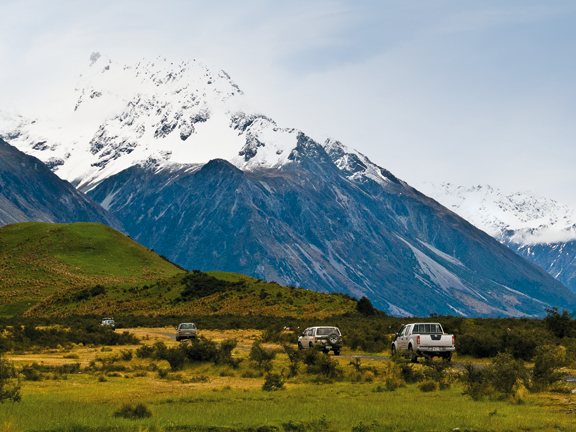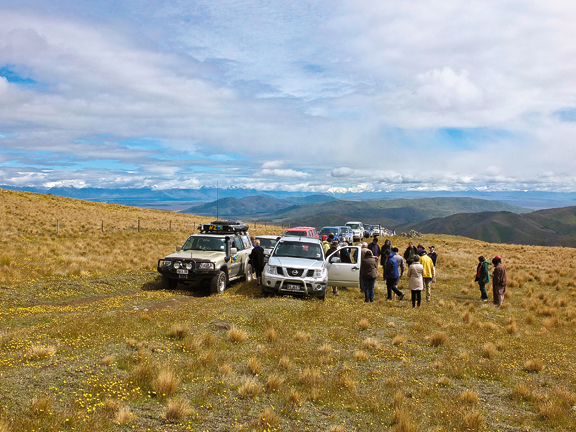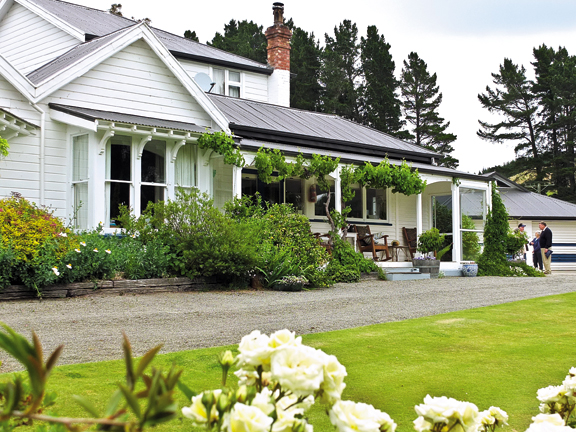The Prado's enormous tyres eased us up the tortuous ledge, instilling confidence in the vehicle's ability to handle challenging terrain, even when the hands behind the wheel are unskilled.
In Christchurch Bill and I had been lent this 4WD, three-litre, turbo, automatic grunt-machine by Overland 4WD Rentals Ltd. Tony Davys, the company's owner and a serious off-roader, told us of his own adventures in the Prado - tales of bush-bashing and chancy river crossings with water swirling through the cab.
"So she'll be more than adequate for what you're gonna to do," he said.
What we were going to do over the next six days was to drive through 23 stations of the South Island's high country. Much of this 1230-kilometre drive would be 'off-road', although the term is misleading as we were always on some sort of track, even if rudimentary. Thankfully there'd be no bush-bashing and the rivers we crossed would be more benign.
The NZ Adventures's tour was led by an awesome foursome, Nancye and Malcolm Langley and Connie and Rob Crickett. All have an intimate understanding of the country and are experienced 4WD drivers.
The expedition began with a briefing in Blenheim. We learnt a new vocabulary - 'gate person', 'cornerman', 'gather-up', 'tail-end-Charlie' - and it became evident that although we would crunch over plenty of rocks on this trip, no stone was left unturned as far as safety and procedure were concerned. Apart from the guides, there were eleven vehicles in the convoy. All but one other couple were farmers.
We assembled next morning in solid rain. By the time we set out, cutting our off-road teeth on the 600m climb to Blairich Pass, sun was dappling the hills of Blairich Station. The track was narrow and rutted, but on that steep ascent there also rose the anticipation of adventure.
This isn't pretty country, it's muscular and monumental. Towering electricity pylons stride across the ridges like giant robots. They'd stay with us for the next four days.
From Blairich Station we hit a precipitous descent into the vine-strewn Awatere Valley, where the deep river bed has carved out its history on high, terraced cliffs.
Lunch was at the homestead on Middlehurst Station. In 1998, Willie and Sue McDonald took on this sizeable chunk of New Zealand (5000ha of freehold land and 11,000ha pastoral lease), which stretches to the snow-struck peaks of the Inland Kaikoura Mountains. Five thousand merino ewes, 4000 hoggets and 500 beef cows graze this isolated terrain, enduring climatic extremes from minus ten to 40°C and an average of 200 frosts per year. Rain is never reliable.
No one would take this country on unless they had gumption. The problems are as huge as the landscapes. Along with the complexities of isolation and the vagaries of the climate, the invasions of hieracium, broom, briar, rabbits, wilding pines, Spaniard thistles and infestations of viciously-thorned matagouri bushes, were themes we would become familiar with over the next few days.
Soon after Middlehurst we crossed Muller Station and entered Molesworth. Dust sprouted from wheels and forced our vehicles to spread out across Isolated Flat. Bald-sided mountains lumbered north behind hills folded like pleated skirts.
Like everybody who crosses the Molesworth, we stopped at Acheron House, built of cob in the 1860s and miraculously surviving. Clumps of gooseberry, cherry and apple trees grow wild around the dusty dwelling and cause no problem, which is more than can be said for the runaway scourge of broom and wilding pines. As we drove down to Hanmer Springs from Jollies Pass, the flowering broom looked as if a liberal layer of turmeric had been spread far across the hills. It was evident what a predicament it has become.
Another highlight was a visit to MacDonald Downs Station near Pyramid Valley. Bill and Phil Paterson bought this high, 10,500ha tussock land in 1966. You have to think big in this sort of country. On MacDonald Downs there are four cattle yards, seven sheep yards and 150 kilometres of internal roads. Four thousand tonnes of silage is made every year to boost winter feed for 11,000 sheep and 800 head of cattle. Bill Paterson inspired the farmers among us with his obvious command of high country management. He led the convoy across the measureless hills to a tawny peak called Blue Mountain and from there he pointed out the station's boundaries - from far-flung mountain ranges to a distant sea. I discovered what 10,500ha actually looks like.
Later, we looped over Okuku Pass into Lees Valley for lunch with Rob and Sue Stokes of Richon Station. After the tussock country, the great stretch of the Lees was like a lawn, and yet farming here in the harsh climate is just as tough.
From there the route swung along a narrow ledge through Ashley Gorge and emerged at Oxford. Then it was up over Porter's Pass to skirt Lake Linden, which can freeze so solid in winter that daring drivers execute wheelies on the ice. Our passage through the Acheron Valley was stunning. Great mountains swept from the valley floor like grand gestures and disappeared into a curtain of fog. We zig-zagged down a steep incline to cross the Rakaia River, and by evening we were comfortably cosseted in a Methven lodge.
One of the aspects of this NZ Adventures' tour that was completely unexpected was the high standard of accommodation and meals sumptuous enough to satisfy the most demanding appetites. Each night we left the stations to stay in one of the small towns along the way, not in backpackers or bland motels, but in comfortable four-star lodges or hotels. Except for one picnic and a feast in the Vulcan pub at St Bathans, lunches were catered for by station owners, namely on Middlehurst, Richon, Lake Heron and Cluden. We were given the royal treatment at each of these and plied with large quantities of home-grown lamb and beef, lashings of salads, home-made baking, and always at least one cream-laden pavlova.
Many of the historic homesteads on these stations have housed several generations of one family, the children inheriting the love of life on the land from their parents. Over the years the buildings have been added to, embellished and surrounded by lavish country gardens and sweeping lawns.
On the third day, a ceiling of low cloud drizzled on the convoy as it headed out, but nothing could dampen the splendour of the drive up the south bank of the Rakaia Gorge. The river's pearly braids wove along its stony bed, which at that time of the year was coloured by a dazzling display of lupin, broom and briar rose. We crawled along, dwarfed to the size of beetles by the ancient, overpowering landforms. There's not much flat land here but grazing and cropping makes use of terraces and stable glacial fans. Bouncing and skittering over rifts of sharp stones, we clawed our way over one terminal moraine that was still active.
The weather closed in. A slushy trail led us through Glenfalloch Station to Lake Stream and eventually into the stunning, mountain-bordered country of the Lake Heron basin. It was no Sunday drive, but everybody was gaining confidence in handling the rough stuff.
From a driving perspective, day four was the most taxing. On Black Forest Station the haul up to 1300m was a real adrenalin run. On high alert, we juddered and slewed up the narrow ledge, avoiding saw-sided rocks that could gouge a tyre wall in a second. The slopes plunged alarmingly. I chanced a glance into the valley we'd just left. It had become a worm trail, the great river now weaving along it like a thread of cotton.
"Avoid those bank-side rocks!" Malcolm called through the intercom. "Stick to outside edges. They won't crumble like they do in the North Island!" Yeah, right!
We reached the pinnacle unscathed and then down a spine-tingling zigzag road we plunged to sink like a sigh into a deep valley. I caught glimpses of wallabies and one weasel the colour of ginger biscuits.
I don't want to imply that there was daredevil in these drives. Serious off-roaders might scoff, but for rookies it certainly had its moments. All the while my affection for Tony's Prado had grown. It took every twist and turn, every boulder or muddy track, and every gurgling river in its stride.
Another exhilarating drive was through Oteake Conservation Park (ex-Twinburn Station), where we tackled billowing tussock-covered hills and rose almost to the snowline to look back from a giddy height to Aoraki/Mt Cook, lording over the Southern Alps. The vista was intoxicating. On the plains far below, Lakes Ohau and Pukaki spread out like turquoise puddles.
"This'll do me," said someone, gazing in awe at the spectacle.
Another day, this time on Northburn Station, we climbed up through fields of wild thyme to 1700 metres. At the great tor of Leaning Rock we hit remnants of snow - not much but enough to have us horsing about like kids out of school.
On the sixth day we climbed again, this time up the Pisa Range, through the Ski Park and vehicle 'proving grounds'. We were there, not to ski or prove anything, but to drive to Mount Pisa to look at the view. A thick layer of snow on the track got the better of us.
No matter, we were high enough on the whole six-day experience. At the Cardrona Hotel that night, the talk was of how much we'd learnt about aspects of our own country, and we toasted new friendships and our newly found off-road skills. Most of us decided that given the chance, we'd do it all again.
No words or pictures adequately describe the high country of New Zealand. Bill had photographed obsessively and I could write a book. But it would serve no purpose. Being there is everything.
Feel free to make a comment or ask us a question about this story on the MCD  page.
For the latest reviews, subscribe to our Motorhomes, Caravans & Destinations magazine here.
page.
For the latest reviews, subscribe to our Motorhomes, Caravans & Destinations magazine here.
 page.
For the latest reviews, subscribe to our Motorhomes, Caravans & Destinations magazine here.
page.
For the latest reviews, subscribe to our Motorhomes, Caravans & Destinations magazine here. 









